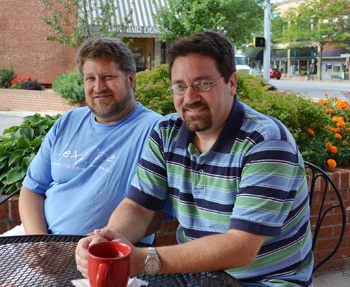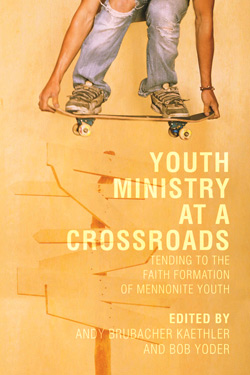Youth ministry book emphasizes ‘being church together’

>> PURCHASE the book for $15.99 from Herald Press on their website.
>> LISTEN to a podcast of an interview with the editors, Bob Yoder and Andy Brubacher Kaethler, is available on the website of Laurelville Mennonite Church Center.
A joint release of Goshen College and Associated Mennonite Biblical Seminary
GOSHEN, Ind. – Bob Yoder has heard congregational youth group leaders say they are afraid to lead Bible studies, fearing they do not have enough training. He also senses people are afraid to talk about their faith in their congregations.
In contrast, Yoder said, he would like to see every person being able to “articulate their hope in Christ in the context of the church.” That’s how he answered a question asked recently at a workshop he led on ministry with youth, and that answer reflects a goal for a new book, Youth Ministry at a Crossroads: Tending to the Faith Formation of Mennonite Youth, edited by Yoder and Andy Brubacher Kaethler.
Recently released by Herald Press and the Institute of Mennonite Studies, the book encourages congregations to take seriously their role in the faith formation of youth. Both editors come to the subject from their own involvement with youth in the Mennonite Church: Yoder is campus pastor at Goshen College and previously was conference youth minister for Indiana-Michigan and Central District Mennonite Conferences. Kaethler is director of !Explore: A Theological Program for High School Youth and an instructor at Associated Mennonite Biblical Seminary.
Yoder noted that Mennonite congregations often draw on generic curriculum for their ministry with youth. “How do we work at nurturing our distinctive faith when we’ve been drinking from this stream for decades?” he asked.
“There has been an explosion of youth ministry materials in the recent past,” Kaethler said. “We believe there is a place for Anabaptist reflection on the themes that are important in ministry with youth.”

Youth Ministry at a Crossroads is not a kit of program materials, but instead examines how to incorporate Mennonite and Anabaptist themes in ministry. The content is shaped around three sections — Being, Knowing and Doing, a model that encompasses the aspects of discipleship important to Mennonites. These three themes are linked to Jesus’ threefold promise of being the Way, the Truth and the Life in John 14.
“The primary emphasis of the book is formation of youth,” Kaethler said. “We are encouraging congregations to continue to involve youth in the life of the church rather than to see youth as the objects or consumers of a program.
“Being followers of Jesus is what guides our ministry with youth,” Kaethler continued. “For example, we organize service projects not because we want to teach kids about service, but because it is what we all do as part of our faith. We don’t do ‘fun’ things with adolescents because they need to be entertained, but we find joy in being church together.”
In the book, 12 writers reflect theologically on issues such as worship, technology, discipleship, consumerism, and Christian faith and hope; and give practical implications and recommendations for further reading.
“Some topics in the book are ones we would not find anywhere else,” Kaethler said. “Some we wanted to give a Mennonite perspective to.” For example, reading the Bible is a subject for which the editors especially wanted to give an Anabaptist perspective, while the dark night of the soul — lament and expressing loss and grief — is an unusual topic for ministry with youth.
“We asked people involved in ministry, people who brought something to the table in their experience or education,” Yoder explained. They included writers from different racial and ethnic groups and from both Mennonite Church Canada and Mennonite Church USA.
Recognizing that people who are involved in youth ministry are often busy people serving as volunteers, Yoder and Kaethler had a goal of making sure the chapters are short. Readers can jump in anywhere, without having to read the book from beginning to end.
The idea for the book emerged from a youth ministry symposium at AMBS in 2006. At that gathering of youth ministry workers, speaker Kenda Creasy Dean, a professor of youth, church and culture at Princeton Theological Seminary, named four things the church needs to give youth: a language of faith, a community in which this is learned, a vocation or purpose in life, and a sense of hope, Kaethler reflected. These four things “connect our identity and our vocation with what God is doing in the world. That’s missional.”
After the symposium, Kaethler and Yoder began conversations with youth ministry workers in the Mennonite Church, and from that grew the plan for this resource. Two Mennonite Education Agency Peoplehood Grants helped to fund the symposium and the distribution of the book to current youth workers, conference and area church ministers, and Mennonite camps and high schools.
– Written by Mary E. Klassen
Editors: For more information about this release, to arrange an interview or request a photo, contact Goshen College News Bureau Director Jodi H. Beyeler at (574) 535-7572 or jodihb@goshen.edu.
###
Goshen College, established in 1894, is a residential Christian liberal arts college rooted in the Anabaptist-Mennonite tradition. The college’s Christ-centered core values – passionate learning, global citizenship, compassionate peacemaking and servant-leadership – prepare students as leaders for the church and world. Recognized for its unique Study-Service Term program, Goshen has earned citations of excellence in Barron’s Best Buys in Education, “Colleges of Distinction,” “Making a Difference College Guide” and U.S. News & World Report’s “America’s Best Colleges” edition, which named Goshen a “least debt college.” Visit www.goshen.edu.




